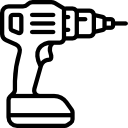- اتو لوله سبز
- اره پروفیل بر
- اره عمودبر (اره چکشی)
- اره فارسی بر
- اره گرد (اره دیسکی)
- اره مویی
- اره میزی
- اره نواری (گوشت بری)
- اره همه کاره (افقی بر)
- ابزار چندکاره
- بالابر برقی
- بتن ساب و موزایک ساب
- بکس برقی
- پیچگوشتی برقی
- پیستوله برقی
- بیسکویت زن
- چکش تخریب
- دمنده/مکنده (بلوور)
- دریل بتن کن
- دریل ساده (سرکج)
- دریل ستونی
- دریل ضربه ای/چکشی
- دریل مغناطیسی (مگنتی)
- دریل نمونه بردار (کرگیر)
- دستگاه جوش
- رنده و فرز نجاری
- سنباده برقی
- سشوار صنعتی
- سنگ دوطرفه (چرخ سنباده)
- سنگ و پولیش
- شیارزن و مرمربر
- فرز مینیاتوری
- فرز انگشتی
- میخکوب و منگنه کوب
- مینی سنگ
High-Security Locks Explained Key Features and Protection Levels for Safety
In a world where security concerns are paramount, selecting the right locking mechanism can make a significant difference in safeguarding your property. High-security locks offer a robust solution against unauthorized access, making them indispensable for both residential and commercial applications. These locks utilize advanced technology and materials that enhance their ability to resist tampering and forced entry.
One of the standout features of modern high-security locks is their smart lock encryption, which provides an added layer of protection that distinguishes them from traditional locks. This technology not only encrypts the communication between the lock and the access control system but also ensures that only authorized individuals can gain entry. The integration of smart technology in high-security mechanisms marks a shift towards more sophisticated locking solutions.
It’s important to consider the locksmith grade of a lock when evaluating its security level. Locksmith grade refers to the strength and durability of the locking mechanism, and it is a key indicator of how well a lock can withstand various threats. High-grade locks are rigorously tested to ensure they meet industry standards, providing peace of mind to those who prioritize safety.
Key Features of High-Security Locks
High-security locks incorporate several advanced features designed to provide superior protection. One of the standout characteristics is the presence of a reinforced bolt. This component enhances resistance to physical attacks, including forced entry attempts. The robust construction of the bolt ensures that it withstands significant pressure, deterring burglars.
Another significant feature is the complex keyways, which are custom-cut to prevent unauthorized duplication. These key profiles require specialized equipment to replicate, making it exceedingly difficult for would-be intruders to create a copy.
High-security locks also utilize advanced pin and tumbler systems, which include additional pins and components that provide increased security. These mechanisms are engineered to resist picking, a common method used by thieves.
Additionally, some high-security locks offer features like drill resistance and pick resistance. These locks are often constructed from materials designed to withstand drilling attempts and incorporate mechanisms that increase their ability to resist picking tools.
Last but not least, many high-security locks come with restricted access control. Manufacturers often implement a system where only authorized locksmiths can provide replacement keys, adding another layer of protection.
Comparing Protection Levels: What Do They Mean?
High-security locks are designed to provide varying protection levels based on specific features and certifications. These levels indicate how well a lock can resist unauthorized access and manipulation. Understanding these levels helps in making informed decisions about security needs.
The protection level is often determined by the lock’s resistance to picking, drilling, and other forms of forced entry. Higher-rated locks typically incorporate advanced technologies and materials, making them more secure. Certification from recognized standards organizations is crucial, as it assures users of a lock’s reliability under different threat scenarios.
Restricted keys are a common feature in high-security locks, limiting their duplication to authorized providers. This reduces the risk of unauthorized copying and enhances overall security. Access to these keys is carefully controlled, ensuring that only trusted individuals can obtain new copies.
Smart lock encryption adds another layer of protection, utilizing electronic systems to secure access. These locks can include features like remote access, biometric verification, and activity logs. Strong encryption protocols ensure that communications between the lock and its controlling device remain secure from cyber threats.
When comparing protection levels, consider both physical attributes and technological advancements. The right choice of lock is contingent upon assessing personal security needs and potential threats effectively.
Common Vulnerabilities and Mitigation Strategies
High-security locks, despite their robust design, can still exhibit vulnerabilities that may be exploited by determined intruders. Awareness of these vulnerabilities and implementation of effective mitigation strategies is essential for enhancing security.
- Key Duplication: Restricted keys can limit access, but if a key is duplicated without authorization, security is compromised. Utilize locksmiths that offer high-security key systems to ensure proper restrictions and monitoring.
- Manipulation: Some high-security locks are susceptible to picking attempts. Choosing locks with pick resistance features, such as those meeting locksmith grade standards, can reduce this risk.
- Drilling: Even high-security locks can be vulnerable to drilling. Installing locks with a drill-resistant core can significantly enhance protection against such attacks.
- Smart Lock Vulnerabilities: Smart locks equipped with encryption technology can mitigate risks associated with digital hacking. Regular updates to firmware and secure passwords are crucial for maintaining security.
- Lock Certification: Always opt for locks that have undergone relevant lock certification tests. This can provide assurance regarding their performance and reliability in securing premises.
By understanding the common vulnerabilities associated with high-security locks and employing the recommended mitigation strategies, property owners can significantly enhance their security posture. For further assistance and guidance, consider visiting https://kklocksmith.com/.
Choosing the Right High-Security Lock for Your Needs
Selecting a high-security lock involves understanding specific characteristics that align with your safety requirements. Prioritize locks featuring an anti-bump design, which prevents unauthorized entry through lock bumping–a common burglary technique. This feature is essential for enhancing security against experienced intruders.
Consider the grade of the lock. A locksmith grade lock typically offers higher durability and better resistance to forced entry compared to standard locks. Opting for commercial grade options is advisable for businesses that require robust security in high-traffic areas.
Restricted keys are another key feature to examine. These keys cannot be duplicated easily, as they are issued only to authorized individuals. This adds an extra layer of security, ensuring that only designated people can access certain areas.
Reinforced bolts are crucial for preventing break-ins. They provide extra strength against physical attacks, making it difficult for intruders to tamper with or break the lock. Additionally, a drill-resistant core safeguards against attempts to compromise the lock through drilling, a method used by many criminals.
Assessing these features based on your specific environment and security needs will guide you in choosing the most suitable high-security lock. Whether for residential or commercial use, understanding these factors ensures effective protection against unauthorized access.




